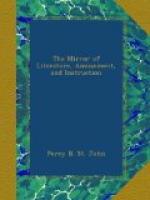[2] This tomb, according to
Archdall’s “Monasticon Hibernicum,”
stood
in the middle of the choir of Kilcrea Abbey, with the
following
inscription:—
Hic.
IACET. CORMACVS. Fil. THADEI.
Fil. CORMACI. Fil. DERMITII.
Magni.
Mc. Carthy. DNVS de.
MVSCRAIGH. FLAYN. AC. ISTIVS.
CONVENTVS.
PRIMVS. FVNDATOR. An. Dom.
1494.
[3] The original name of a
sept or clan was Carty, supposed to be
derived
from Cartheigh, which signifies an Inhabitant of the
Rock;
and Mac, denoting “son of;” was
used before the father’s
Christian
name for the purpose of distinction, as, Mac Cormac
Carty
expressed Carty, son of Cormac; this manner of designation
appears
discontinued on the introduction of a greater variety
of
names,
and the Mac alone retained by the elder branches.
[4] Amongst the Harleian MSS.
the Vol. No. 1425, contains pedigrees
of
Irish nobility; from the ninth to the twenty-second
page is
occupied
by those of “Mac Cartie More,” Mac Cartie
Reagh, and
all
other Mac Carties, brought down to the year 1615; but
though
curious
for reference, there is little worth the trouble of
transcribing.
The most common female names in the Mac Carty
pedigree
are, Katheren, Elin, Honnor, Joan, and Grany.
The military and historic recollections connected with Blarney are doubtless of sufficient importance to give an interest to the place; but to a curious superstition it is perhaps more indebted for celebrity. A stone in the highest part of the castle wall is pointed out to visitors, which is supposed to give to whoever kisses it the peculiar privilege of deviating from veracity with unblushing countenance whenever it may be convenient—hence the well-known phrase of “Blarney.”




